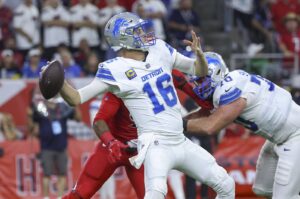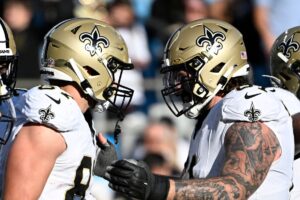Ever since Drew Brees took over as the New Orleans Saints starting quarterback in 2006, there have been few concerns about the passing game. The NFL’s all-time passing yards leader had helped the Saints finish fifth or better every year in total passing yards until last season.
Despite setting a new single-season record with a 74.4 completion percentage in 2018, Brees and the Saints offense struggled to meet their productivity standard and finished 12th in total passing yardage.
The problem was simple. Aside from wide receiver Michael Thomas and running back Alvin Kamara, the Saints receiving corps lacked proven talent. It didn’t help that number two wide receiver Ted Ginn missed all but five regular season games. When opposing defenses successfully minimized Thomas and Kamara, Brees struggled to find open targets in a passing attack once known for its depth and versatility.
Fortunately, New Orleans made a big move in free agency to give Brees another target. They signed 6’5″ veteran tight end Jared Cook, a valuable receiving threat who is fresh off his first Pro Bowl selection. While there are other issues facing the Saints 2019 passing offense, the Cook signing addressed the unit’s biggest concern and his presence should lead to an overall boost in pass production.
Here are some factors that could influence the Saints 2019 passing offense this season.
Looking at the New Orleans Saints 2019 Passing Offense
What Cook Could Contribute
To see what kind of effect a tall, athletic tight end like Cook could have on the Saints offense, one could look to Jimmy Graham‘s years in New Orleans. Brees amassed over 4,900 passing yards from 2011-2014, when Graham was the cornerstone of the passing game. With targets like Darren Sproles, Marques Colston , and Lance Moore also in the mix, there was almost always someone open.
Ben Watson also had some success with New Orleans in 2015 and 2018, but while he is a well-rounded in-line tight end, he can’t do things like this; run a wheel route from the full back spot, then get open and make a catch behind a linebacker in the flat before the safety can react. If Cook can beat defenses like this, it will open up what the Saints can do with formations and route concepts, and give them a much-needed third playmaker alongside Thomas and Kamara.
Graham’s mere presence on the field also proved to be a great asset. Few defenders proved capable of covering him one on one so he was often shadowed or double-teamed, which opened up opportunities for other receivers.
On this 2011 touchdown pass to Colston, Graham lined up as the outside wide receiver on the left. Not only did Graham draw coverage from the cornerback, he also had the attention of the safety on that side. This opened up space for Colston, the slot receiver, in the end zone once he got behind the zone linebacker.
Graham also opened up opportunities for receivers coming from the backfield as seen on this Sproles touchdown catch in the 2011 playoffs. Graham again drew coverage from a cornerback on the left side, while safety Dashon Goldson slid far to Graham’s side pre-snap to offer support. Goldson’s adjustment gave Sproles a deadly angle on the safety as Brees hit him on a slant route and Goldson was unable to recover.
Of course, there’s no guarantee that Cook will reach this potential in the Saints offense. Cook turned 32 this year and he isn’t quite the athletic marvel Graham was 5-10 years ago. Nonetheless, he brings a similar skill set to New Orleans, and coaches will surely revisit these kinds of plays this season and try to replicate them.
Year Two for Several Receivers
As Cook assimilates into the offense, five receivers will try to improve in their second season in the Saints offense after underwhelming debuts.
2018 third round pick Tre’Quan Smith led this group with 28 catches, 427 receiving yards and five touchdowns, but much of his production came in games against the Washington Redskins and Philadelphia Eagles. While those games provided a glimpse at the rookie’s great potential, Smith recorded just 15 receptions for 159 yards and two touchdowns in his other 13 regular season efforts. He contributed two catches for 25 yards in the postseason.
Cameron Meredith, a promising 2018 free agent signing was never fully healthy as he struggled to recover from a 2017 ACL injury. He missed the Saints first two regular season games and landed on injured reserve after appearing in just six games. Undrafted receivers Keith Kirkwood, Austin Carr, and Dan Arnold all had good moments last season, but none were ready to become difference-makers.
Thanks to the Cook signing and Ginn’s return from injury, there will be less pressure on this group to contribute. However, the Saints passing attack has always been at its best when each target is capable of consistently making plays. This was the hidden strength of the Saints passing offense in its peak years earlier in the decade when Brees would routinely connect with seven or more receivers in a game.
If just two of these receivers can perform better in 2019, that’ll give the entire passing game a boost.
Brees Arm Strength in Decline?
No one likes discussing this topic as its been overblown by reporters for years, but Brees finally showed genuine reasons for concern late last season.
Some observed that the 18-year veteran’s arm strength seemed diminished following a hit he took while trying to defend an interception return against the Atlanta Falcons on Thanksgiving. While no injury was officially reported, analytics guru Warren Sharp pointed out that his deep passing stats suffered greatly following the hit.
There are a few ways to digest this information. You can believe that Brees was limited late in the season by a minor injury such as bruised or cracked ribs, which shouldn’t be a long term concern. Another potential explanation is that Brees has reached an age where his throwing ability naturally declines through the course of each grueling NFL season but resets after rest in the off-season. Although fans won’t want to admit it, it’s also likely that he’s simply gradually and permanently losing arm strength.
The truth is probably some combination of these explanations. As a player gets older, it’s more difficult to stay healthy all season and fight through any ailments that afflict them. While many injuries heal quickly, cumulative damage and wear to the body will eventually have an effect on the player’s strength, flexibility, and resilience. Overall physical decline is natural, but often subtle in top athletes like Brees.
Remarkably, Brees has only missed one game due to injury through 13 years in a pass-heavy Saints offense. His deep passing issues late last season may be one of the first concrete signs that his invincibility won’t last forever.
Other Concerns
A new center will be tasked with keeping Brees healthy this season. It will either be rookie Erik McCoy or two-year veteran Nick Easton, a free agent signing who missed all of last season due to injury. Whoever wins the starting job will lack experience, but at least New Orleans has two options to replace the excellent play of former starter Max Unger. The strength of the rest of the offensive line will also ease the transition.
The issues Brees had when throwing downfield last season were amplified by a lack of deep threats, especially when Ginn was out of action. A healthy Ginn in 2019 should still be able to stretch the field, but at 34 years old, he shouldn’t be their only true deep target.
Smith may be the best option to supplement Ginn. He averaged 19.8 yards per catch in his senior year of college and made a few plays downfield last season. While Smith clearly has the speed to become a genuine deep threat, he needs to find ways to get more separation downfield.
Bottom Line on the Saints 2019 Passing Offense
Unless Brees shows a drastic decline in ability this season, there aren’t many reasons to worry about the Saints passing game. Brees and head coach Sean Payton almost always find ways to produce no matter what they have to work with and Cook should make their jobs easier against top-end coverage defenses.
There are reasons to be concerned about the supporting cast at wide receiver, but there should be enough talent there to find answers for the third and fourth receiver spots. Seventh-round draft pick and tight end Alize Mack could also contribute if he can quickly absorb the offense.
The biggest takeaway is that with the addition of Cook, Brees now has a Pro Bowl tight end, an All-Pro wide receiver (Thomas), and a dual-threat Pro Bowl running back (Kamara) at his disposal. This is perhaps the best trio of weapons Brees has ever had, and they should overshadow the potential shortcomings of the team’s other skill players.
Main Photo:
Embed from Getty Images






